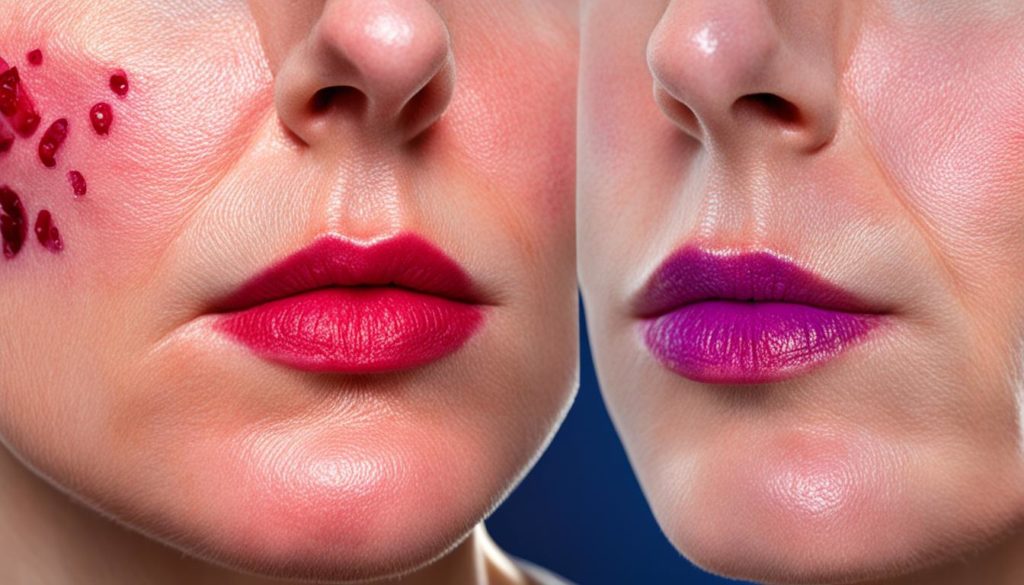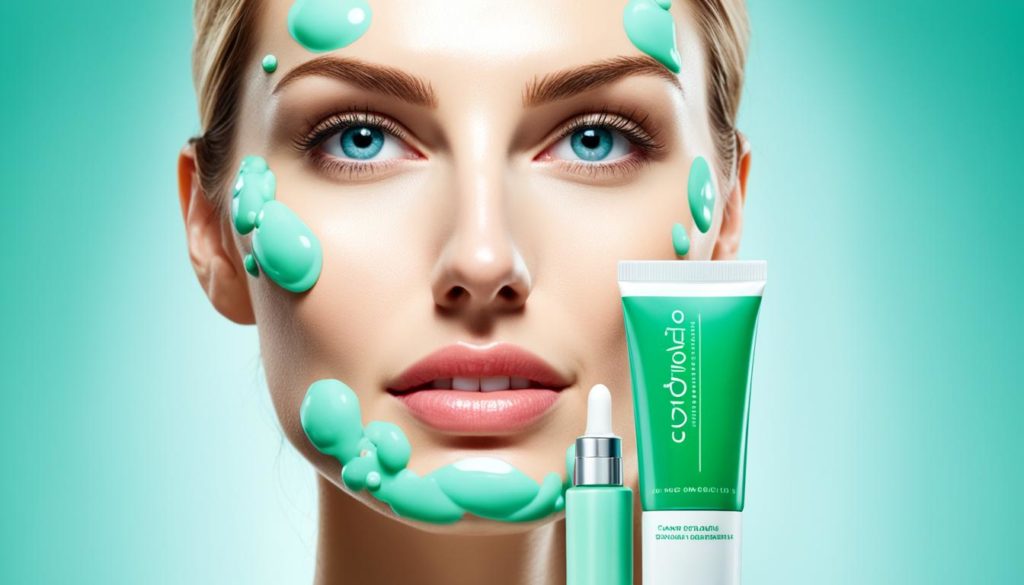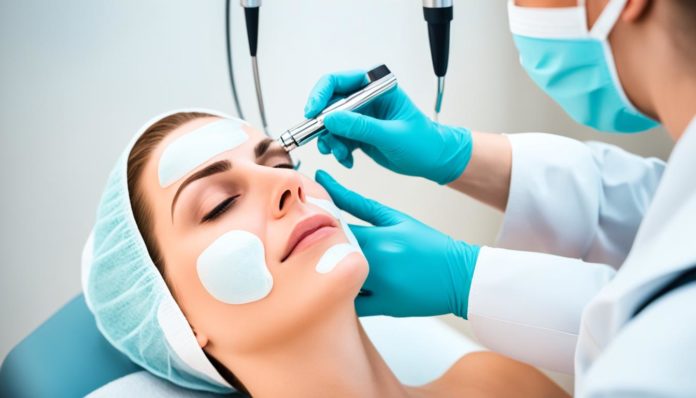Did you know nearly 20% of dermatology patients have cystic acne? This type is far more severe. It often leaves deep scars and lasting redness. Important to treat it well, cystic acne treatment helps avoid long-term skin damage and boosts confidence. We’ll delve into cystic acne insights and offer therapeutic options for severe acne management.
We’re going to look at various treatments. These range from over-the-counter methods to prescription meds, and advanced light and laser therapies. We’ll also talk about natural remedies and ways to prevent acne from coming back. By the end, you’ll know how to manage cystic acne effectively.
Key Takeaways
- Understanding the nature and causes of cystic acne is the first step towards effective treatment.
- Topical treatments range from over-the-counter options to prescription-grade formulas.
- Oral medications can offer significant relief, particularly in severe cases.
- Hormonal treatments are essential strategies in managing acne linked to hormonal imbalances.
- Incorporating natural remedies and maintaining a proper skincare routine are effective ways to prevent flare-ups.
Understanding Cystic Acne
Handling cystic pimples is tough, especially with severe inflammation and discomfort. Knowing about cystic acne is key to manage and treat it well.
What is Cystic Acne?
Cystic acne is a severe acne type, marked by large, deep, and painful cysts under the skin. Unlike others, cystic pimples form from deep skin infections, creating pus-filled lumps. They may take weeks to heal.
Causes of Cystic Acne
Many factors cause cystic acne. Hormonal changes, like puberty or pregnancy, and genetics can lead to breakouts. Also, a high-sugar diet or much stress makes it worse.

Symptoms to Watch For
It’s crucial to identify symptoms early for treatment. Look out for:
- Large, tender cysts beneath the skin
- Redness and intense inflammation
- Painful lesions that may cause scarring
- Frequent outbreaks on the face, back, shoulders, and chest
If you see these signs, seeing a dermatologist for treatment advice is wise.
Topical Treatments for Cystic Acne
Topical treatments aim right at the issue of cystic acne. They use active ingredients to fight the infection and inflammation on the skin. These products, whether bought over-the-counter or prescribed by a doctor, can really help when added to your skincare routine.

Over-the-Counter Options
There are many options out there to help with cystic acne. Look for products with benzoyl peroxide and salicylic acid. These are key.
- Benzoyl Peroxide: It kills the bacteria behind acne. Plus, it helps remove extra oil and dead skin cells.
- Salicylic Acid: This helps peel the skin gently, unclogging pores. It also lessens swelling and redness.
Adding these to your routine can make a big difference. But watch how your skin reacts. You might need to use them less if your skin gets too dry or irritated.
Prescription Treatments
For tough cases, doctors often suggest stronger, prescription treatments. Popular ones include topical retinoids and antibiotic creams.
- Topical Retinoids: These come from vitamin A. They boost cell turnover and stop pores from clogging. Retinoic acid is a common type.
- Topical Antibiotics: They fight bacteria and calm inflammation on the skin. Doctors often use clindamycin and erythromycin.
These stronger options can make a big impact. Always follow your doctor’s advice to avoid bad side effects.
Oral Medications for Severe Acne
For severe acne, oral medications are key. They work from inside to fight the root causes, like bacteria and oil. This gives better results than just using creams.
Antibiotics
Antibiotics are a go-to for tough acne. They lessen inflammation and fight bacteria. Tetracycline, doxycycline, and minocycline are some you might use. It’s vital to stick to what the doctor says to avoid any risks.
Isotretinoin
Isotretinoin, or Accutane, is super strong against severe acne. It shrinks oil glands and cuts down on oil. Because it’s so strong, it’s a last resort. Regular check-ups are needed because of serious side effects like dry skin and liver issues.
| Medication | Function | Common Side Effects |
|---|---|---|
| Antibiotics (e.g., Doxycycline) | Reduces inflammation and kills bacteria | Nausea, sun sensitivity |
| Isotretinoin (Accutane) | Decreases oil production, shrinks oil glands | Dry skin, liver toxicity |
Both antibiotic and isotretinoin treatments need a doctor’s watch. They can make a big difference for those with severe acne.
Hormonal Treatments for Cystic Acne
Hormones play a big role in cystic acne. Balancing these hormones can be key to treating it. We’ll talk about two main ways to do this: using birth control pills and spironolactone.
Birth Control Pills
For women, birth control pills can be a game-changer in fighting acne. They work by reducing hormones that lead to oil and clogged pores. Research shows they really help in cutting down acne. But it’s important to talk to a doctor first. They can advise you and tell you about any side effects like mood swings or a higher chance of blood clots.
Spironolactone
Spironolactone is another route for those battling acne caused by hormonal issues. It started as a diuretic but is great at blocking certain hormones linked to oil production. This makes it a top choice for women who see acne flare-ups due to hormonal changes. Always check with a dermatologist to get the dosage right. Watch out for any side effects such as needing to pee more, having irregular periods, or changes in electrolyte levels.
| Hormonal Treatment | Mechanism | Effective For | Potential Side Effects |
|---|---|---|---|
| Birth Control Pills | Regulate androgen production | Reducing acne lesions | Weight gain, mood changes, risk of blood clots |
| Spironolactone | Blocks androgen receptors | Managing hormonal fluctuations | Increased urination, menstrual irregularities, electrolyte imbalances |
Natural Remedies for Cystic Acne
To naturally treat cystic acne, you need to do two things. First, adjust what you eat by following a cystic acne diet. Second, use natural acne remedies. Doing these can make your skin healthier from the inside out.
Diet and Nutrition
Diet greatly affects skin health, especially for cystic acne sufferers. Eating the right foods can lessen how often and how bad breakouts are. Make sure your diet includes:
- Less sugar and high-glycemic foods to avoid inflammation triggers.
- More omega-3 fatty acids from salmon and chia seeds, which fight inflammation.
- Plenty of fruits and veggies to get antioxidants that help your skin heal.
Herbal Treatments
Using natural acne remedies means turning to herbs and plants that help with acne. These include:
- Tea Tree Oil: It fights bacteria and reduces inflammation.
- Green Tea: Drink it or apply it to minimize oil and battle inflammation.
- Aloe Vera: It calms redness and helps skin heal faster.
Effectiveness of Light and Laser Therapy
In recent years, acne light therapy and laser treatment for acne have become more popular. These methods use various lights and lasers to lessen inflammation and bacteria that cause acne.
Blue Light Therapy: This therapy specifically targets the Propionibacterium acnes bacteria, which plays a role in acne. By targeting these bacteria, it can reduce the number and severity of acne breakouts.
Laser Treatment: Using fractional and diode lasers, this treatment reaches under the skin. It boosts collagen and lowers oil production. These effects help in healing acne scars and stopping new acne from showing up.
- Reduces Inflammation
- Kills Acne-Causing Bacteria
- Minimizes Acne Scars
- Prevents Future Breakouts
Effectiveness: Studies have shown good outcomes, with many seeing fewer acne spots after these treatments. But, results can differ among people. Consulting a dermatologist is key to know if these treatments are right for you and how many sessions you’ll need.
| Type | Mechanism | Pros | Cons |
|---|---|---|---|
| Blue Light Therapy | Kills P. acnes bacteria | Non-invasive, minimal downtime | Multiple sessions required |
| Laser Treatment | Stimulates collagen, reduces sebum | Effective for scars, long-lasting results | Side effects like redness, cost |
Skincare Routine for Acne-Prone Skin
Creating a good skincare routine is crucial for acne-prone skin. It’s important to cleanse gently, moisturize with products meant for oily skin, and exfoliate regularly. Using the right products can greatly improve and manage severe acne.
Cleansing
Begin your skincare routine with a soft cleanser. Strong soaps can make cystic acne worse by removing natural oils. This leads to more oil and breakouts. Choose a gentle, non-comedogenic cleanser to clear impurities without blocking pores.
Moisturizing
Even oily skin needs moisture. Pick a light, oil-free moisturizer with hyaluronic acid or glycerin. These ingredients hydrate without triggering acne. Moisturized skin keeps its barrier strong, cutting down inflammation and cysts.
Exfoliation
Exfoliating is critical in acne care. Use products with salicylic acid to remove dead cells and open pores. But, be careful not to overdo it, as that can irritate your skin and make acne worse. A steady skincare regime clears the path to healthier skin.
| Step | Product Type | Recommended Ingredients |
|---|---|---|
| Cleansing | Non-comedogenic cleanser | Aloe vera, Chamomile |
| Moisturizing | Oil-free moisturizer | Hyaluronic acid, Glycerin |
| Exfoliation | Salicylic acid exfoliant | Salicylic acid |
Acne Prevention Tips
Healthy skin habits are crucial for preventing acne. Stick to a regular routine and make lifestyle changes to cut down on breakouts.
Healthy Habits
To stop acne, add healthy habits to your day. Drinking enough water keeps the skin in good shape. Getting plenty of sleep lets the body fix and make new skin cells.
Exercising boosts blood flow and oxygen to the skin. It also gets rid of toxins. Learning to manage stress through methods like mindfulness can also lower the chance of acne caused by stress.
“Healthy skin habits, including staying hydrated and managing stress, are essential steps in acne prevention,” advises dermatologist Dr. Jeremy Fenton.
- Drink at least eight glasses of water daily.
- Engage in 30 minutes of exercise per day.
- Prioritize 7-9 hours of sleep every night.
- Practice stress-relief techniques regularly.
Regular Skincare Routine
A good skincare routine is key to clear skin and stopping acne. Use products that match your skin type and stick to your routine to see results.
| Step | Description |
|---|---|
| Cleansing | Use a gentle, non-comedogenic cleanser to remove dirt and excess oil. |
| Moisturizing | Apply an oil-free moisturizer to keep the skin hydrated without clogging pores. |
| Exfoliation | Incorporate a mild exfoliant to remove dead skin cells and prevent clogged pores. |
In summary, stopping acne starts with healthy skin habits and a steady skincare routine. Doing this can greatly reduce breakouts and keep your skin healthy.
Choosing the Right Acne Products
Knowing your skin type is key when picking selecting acne products. Each skin type reacts differently to acne product ingredients. Sensitive skin might like gentle items, whereas oily skin could need stronger things.
Active ingredients are critical in an effective acne treatment. Ingredients like benzoyl peroxide, adapalene, and salicylic acid are proven to fight acne. Always choose based on what your skin needs and how it reacts.
Try a patch test when selecting acne products. It’s crucial to prevent skin irritation and bad reactions. Seek out ‘non-comedogenic’ products, so you won’t clog your pores or cause acne flare-ups.
A complete skincare routine boosts acne treatment success. It’s not just about picking the right acne products. Make sure to clean, moisturize, and exfoliate your skin regularly.
If over-the-counter options don’t improve your skin in 2 to 3 months, see a doctor. They can offer personalized advice and stronger treatment options if needed.
Conclusion
Understanding cystic acne is key to managing it well. We’ve looked at causes, symptoms, and many treatments. Options like creams, pills, hormone help, natural ways, and laser therapy were discussed. Choosing the right treatment with a doctor’s help is crucial.
A good skincare routine for acne-prone skin helps a lot. Adding prevention methods and the right acne products is vital. This way, you reduce severe outbreaks. Combining personalized treatments and skin care makes a big difference in your skin’s health and confidence.
The aim is to give you knowledge and encourage you to take action. For those facing cystic acne, there is hope and a chance for better skin. Making informed choices and getting help from skin experts are key steps. Getting clear skin can be tough, but the many treatment options offer a hopeful route.
FAQ
What is Cystic Acne?
Cystic acne is a severe acne type, causing big, swollen cysts under the skin. It differs from other acne forms as it leads to deep, painful bumps. Getting the right treatment early is key to avoiding scars.
What causes Cystic Acne?
Hormone changes often trigger cystic acne, especially during puberty or periods. It can also come from genes, stress, or your lifestyle. Knowing what causes it can help you manage it better.
What are the symptoms of Cystic Acne?
If you have cystic acne, you’ll notice deep bumps that hurt, along with a lot of swelling and redness. These bumps can stick around and leave marks. Spotting these signs early makes treatment more effective.
What are some over-the-counter topical treatments for Cystic Acne?
You can treat cystic acne with over-the-counter products like benzoyl peroxide and salicylic acid. They lessen swelling and clear pores well. Yet, if your acne is really bad, a doctor’s visit for stronger medicine might be needed.
What prescription topical treatments are available for Cystic Acne?
Doctors might prescribe stronger stuff for cystic acne, like retinoids and antibiotics. These work well for tougher acne. But, you should use them carefully and watch out for side effects.
What oral medications are used for treating severe acne?
For really bad acne, doctors prescribe antibiotics and isotretinoin. Antibiotics ease inflammation, while isotretinoin fights acne hard. You’ll need a prescription and close doctor watch for these because of their strong effects.
How do hormonal treatments help in managing Cystic Acne?
Hormonal treatments balance your hormones, cutting down on acne breakouts. They work great for acne tied to hormones. You should talk to a healthcare provider to see if these are right for you and to keep an eye on side effects.
Are there any natural remedies for Cystic Acne?
Eating better, like more fruits and veggies while avoiding sugary foods, can help with acne. Natural stuff like tea tree oil and green tea might also improve your skin. Still, they should go along with, not replace, regular treatments.
What role do light and laser therapies play in treating Cystic Acne?
Light and laser treatments, like blue light therapy, fight acne by targeting harmful bacteria and lowering swelling. They are often part of a broader treatment plan. Make sure a trained pro does these sessions to keep things safe and work well.
What should a skincare routine for acne-prone skin include?
For acne-prone skin, start with gentle cleaning and use moisturizers that won’t clog pores. Also, exfoliate wisely to avoid irritating your skin. Finding the right products and using them regularly are crucial for managing acne.
What are the best practices for preventing acne?
To prevent acne, drink lots of water, eat well, sleep enough, manage stress, and stick to your skin care plan. These steps keep your skin healthy and can help stop acne from popping up.
How should I choose the right acne products?
Look for acne fighters like benzoyl peroxide, salicylic acid, and retinoids when picking products. Steer clear of stuff that could upset your skin. Do a test on a small area first. A dermatologist can also offer advice tailored to your skin’s needs.


